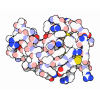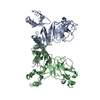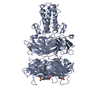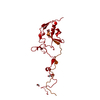[English] 日本語
 Yorodumi
Yorodumi- PDB-5iv5: Cryo-electron microscopy structure of the hexagonal pre-attachmen... -
+ Open data
Open data
- Basic information
Basic information
| Entry | Database: PDB / ID: 5iv5 | ||||||
|---|---|---|---|---|---|---|---|
| Title | Cryo-electron microscopy structure of the hexagonal pre-attachment T4 baseplate-tail tube complex | ||||||
 Components Components |
| ||||||
 Keywords Keywords |  VIRAL PROTEIN / T4 / baseplate-tail tube complex / pre-attachment / VIRAL PROTEIN / T4 / baseplate-tail tube complex / pre-attachment /  bacteriophage / bacteriophage /  bacterial virus / bacterial virus /  hexagonal / membrane-piercing / cell attachment / hexagonal / membrane-piercing / cell attachment /  infection infection | ||||||
| Function / homology |  Function and homology information Function and homology information peptidoglycan beta-N-acetylmuramidase activity / symbiont genome ejection through host cell envelope, contractile tail mechanism / symbiont entry into host cell via disruption of host cell wall peptidoglycan / virus tail, tube / virus tail, baseplate / viral tail assembly / virus tail, fiber / symbiont entry into host cell via disruption of host cell envelope / virus tail / peptidoglycan beta-N-acetylmuramidase activity / symbiont genome ejection through host cell envelope, contractile tail mechanism / symbiont entry into host cell via disruption of host cell wall peptidoglycan / virus tail, tube / virus tail, baseplate / viral tail assembly / virus tail, fiber / symbiont entry into host cell via disruption of host cell envelope / virus tail /  virion component => GO:0044423 ... virion component => GO:0044423 ... peptidoglycan beta-N-acetylmuramidase activity / symbiont genome ejection through host cell envelope, contractile tail mechanism / symbiont entry into host cell via disruption of host cell wall peptidoglycan / virus tail, tube / virus tail, baseplate / viral tail assembly / virus tail, fiber / symbiont entry into host cell via disruption of host cell envelope / virus tail / peptidoglycan beta-N-acetylmuramidase activity / symbiont genome ejection through host cell envelope, contractile tail mechanism / symbiont entry into host cell via disruption of host cell wall peptidoglycan / virus tail, tube / virus tail, baseplate / viral tail assembly / virus tail, fiber / symbiont entry into host cell via disruption of host cell envelope / virus tail /  virion component => GO:0044423 / symbiont entry into host / viral release from host cell / peptidoglycan catabolic process / cell wall macromolecule catabolic process / virion component => GO:0044423 / symbiont entry into host / viral release from host cell / peptidoglycan catabolic process / cell wall macromolecule catabolic process /  lysozyme / lysozyme /  lysozyme activity / killing of cells of another organism / entry receptor-mediated virion attachment to host cell / defense response to bacterium / symbiont entry into host cell / structural molecule activity / identical protein binding / lysozyme activity / killing of cells of another organism / entry receptor-mediated virion attachment to host cell / defense response to bacterium / symbiont entry into host cell / structural molecule activity / identical protein binding /  metal ion binding metal ion bindingSimilarity search - Function | ||||||
| Biological species |   Enterobacteria phage T4 (virus) Enterobacteria phage T4 (virus) | ||||||
| Method |  ELECTRON MICROSCOPY / ELECTRON MICROSCOPY /  single particle reconstruction / single particle reconstruction /  cryo EM / Resolution: 4.11 Å cryo EM / Resolution: 4.11 Å | ||||||
 Authors Authors | Taylor, N.M.I. / Guerrero-Ferreira, R.C. / Goldie, K.N. / Stahlberg, H. / Leiman, P.G. | ||||||
 Citation Citation |  Journal: Nature / Year: 2016 Journal: Nature / Year: 2016Title: Structure of the T4 baseplate and its function in triggering sheath contraction. Authors: Nicholas M I Taylor / Nikolai S Prokhorov / Ricardo C Guerrero-Ferreira / Mikhail M Shneider / Christopher Browning / Kenneth N Goldie / Henning Stahlberg / Petr G Leiman /   Abstract: Several systems, including contractile tail bacteriophages, the type VI secretion system and R-type pyocins, use a multiprotein tubular apparatus to attach to and penetrate host cell membranes. This ...Several systems, including contractile tail bacteriophages, the type VI secretion system and R-type pyocins, use a multiprotein tubular apparatus to attach to and penetrate host cell membranes. This macromolecular machine resembles a stretched, coiled spring (or sheath) wound around a rigid tube with a spike-shaped protein at its tip. A baseplate structure, which is arguably the most complex part of this assembly, relays the contraction signal to the sheath. Here we present the atomic structure of the approximately 6-megadalton bacteriophage T4 baseplate in its pre- and post-host attachment states and explain the events that lead to sheath contraction in atomic detail. We establish the identity and function of a minimal set of components that is conserved in all contractile injection systems and show that the triggering mechanism is universally conserved. | ||||||
| History |
|
- Structure visualization
Structure visualization
| Movie |
 Movie viewer Movie viewer |
|---|---|
| Structure viewer | Molecule:  Molmil Molmil Jmol/JSmol Jmol/JSmol |
- Downloads & links
Downloads & links
- Download
Download
| PDBx/mmCIF format |  5iv5.cif.gz 5iv5.cif.gz | 11 MB | Display |  PDBx/mmCIF format PDBx/mmCIF format |
|---|---|---|---|---|
| PDB format |  pdb5iv5.ent.gz pdb5iv5.ent.gz | Display |  PDB format PDB format | |
| PDBx/mmJSON format |  5iv5.json.gz 5iv5.json.gz | Tree view |  PDBx/mmJSON format PDBx/mmJSON format | |
| Others |  Other downloads Other downloads |
-Validation report
| Arichive directory |  https://data.pdbj.org/pub/pdb/validation_reports/iv/5iv5 https://data.pdbj.org/pub/pdb/validation_reports/iv/5iv5 ftp://data.pdbj.org/pub/pdb/validation_reports/iv/5iv5 ftp://data.pdbj.org/pub/pdb/validation_reports/iv/5iv5 | HTTPS FTP |
|---|
-Related structure data
| Related structure data |  3374MC  3392C  3393C  3394C  3395C  3396C  3397C  5iv7C 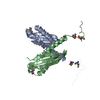 5iw9C M: map data used to model this data C: citing same article ( |
|---|---|
| Similar structure data |
- Links
Links
- Assembly
Assembly
| Deposited unit | 
|
|---|---|
| 1 |
|
- Components
Components
-Baseplate wedge protein ... , 8 types, 96 molecules ABXYuvBHBIEAEBGDGECZwBJECGFDEabxyCACBEDEEGGGH...
| #1: Protein | Mass: 74492.641 Da / Num. of mol.: 12 / Source method: isolated from a natural source / Source: (natural)   Enterobacteria phage T4 (virus) / Plasmid details: am18/am23 mutant / References: UniProt: P19060 Enterobacteria phage T4 (virus) / Plasmid details: am18/am23 mutant / References: UniProt: P19060#2: Protein | Mass: 119336.516 Da / Num. of mol.: 6 / Source method: isolated from a natural source / Source: (natural)   Enterobacteria phage T4 (virus) / Plasmid details: am18/am23 mutant / References: UniProt: P19061 Enterobacteria phage T4 (virus) / Plasmid details: am18/am23 mutant / References: UniProt: P19061#3: Protein | Mass: 38041.668 Da / Num. of mol.: 12 / Source method: isolated from a natural source / Source: (natural)   Enterobacteria phage T4 (virus) / Plasmid details: am18/am23 mutant / References: UniProt: P19062 Enterobacteria phage T4 (virus) / Plasmid details: am18/am23 mutant / References: UniProt: P19062#4: Protein | Mass: 31024.725 Da / Num. of mol.: 18 / Source method: isolated from a natural source / Source: (natural)   Enterobacteria phage T4 (virus) / Plasmid details: am18/am23 mutant / References: UniProt: P10927 Enterobacteria phage T4 (virus) / Plasmid details: am18/am23 mutant / References: UniProt: P10927#5: Protein | Mass: 66281.680 Da / Num. of mol.: 18 / Source method: isolated from a natural source / Source: (natural)   Enterobacteria phage T4 (virus) / Plasmid details: am18/am23 mutant / References: UniProt: P10928 Enterobacteria phage T4 (virus) / Plasmid details: am18/am23 mutant / References: UniProt: P10928#6: Protein | Mass: 23725.523 Da / Num. of mol.: 18 / Source method: isolated from a natural source / Source: (natural)   Enterobacteria phage T4 (virus) / Plasmid details: am18/am23 mutant / References: UniProt: P10929 Enterobacteria phage T4 (virus) / Plasmid details: am18/am23 mutant / References: UniProt: P10929#9: Protein | Mass: 15111.101 Da / Num. of mol.: 6 / Source method: isolated from a natural source / Source: (natural)   Enterobacteria phage T4 (virus) / Plasmid details: am18/am23 mutant / References: UniProt: P09425 Enterobacteria phage T4 (virus) / Plasmid details: am18/am23 mutant / References: UniProt: P09425#11: Protein | Mass: 22990.885 Da / Num. of mol.: 6 / Source method: isolated from a natural source / Source: (natural)   Enterobacteria phage T4 (virus) / Plasmid details: am18/am23 mutant / References: UniProt: P16011 Enterobacteria phage T4 (virus) / Plasmid details: am18/am23 mutant / References: UniProt: P16011 |
|---|
-Protein , 5 types, 37 molecules OPQlmnAIAJBADBDCDDFEFFFGHHHIHJRSopBBBCDEDFFHFIIAIB...
| #7: Protein | Mass: 56253.926 Da / Num. of mol.: 18 / Source method: isolated from a natural source / Source: (natural)   Enterobacteria phage T4 (virus) / Plasmid details: am18/am23 mutant / References: UniProt: P10930 Enterobacteria phage T4 (virus) / Plasmid details: am18/am23 mutant / References: UniProt: P10930#8: Protein | Mass: 18479.613 Da / Num. of mol.: 12 / Source method: isolated from a natural source / Source: (natural)   Enterobacteria phage T4 (virus) / Plasmid details: am18/am23 mutant / References: UniProt: P13333 Enterobacteria phage T4 (virus) / Plasmid details: am18/am23 mutant / References: UniProt: P13333#13: Protein | Mass: 63183.723 Da / Num. of mol.: 3 / Source method: isolated from a natural source Details: The chain breaks in gp5 (chains YA, YB and YC) between residues 76 and 77 were introduced by the refinement program. The starting model did not contain these breaks. This region lies in the ...Details: The chain breaks in gp5 (chains YA, YB and YC) between residues 76 and 77 were introduced by the refinement program. The starting model did not contain these breaks. This region lies in the symmetry mismatched region of our map and cannot be refined reliably. The crystal structure of the gp5-gp27 complex - PDB code 1K28 - gives a more precise description of the polypeptide chain conformation at this location. Source: (natural)   Enterobacteria phage T4 (virus) / Plasmid details: am18/am23 mutant / References: UniProt: P16009, Enterobacteria phage T4 (virus) / Plasmid details: am18/am23 mutant / References: UniProt: P16009,  lysozyme lysozyme#14: Protein | Mass: 44431.062 Da / Num. of mol.: 3 / Source method: isolated from a natural source / Source: (natural)   Enterobacteria phage T4 (virus) / Plasmid details: am18/am23 mutant / References: UniProt: P17172 Enterobacteria phage T4 (virus) / Plasmid details: am18/am23 mutant / References: UniProt: P17172#15: Protein | | Mass: 10233.663 Da / Num. of mol.: 1 / Source method: isolated from a natural source / Source: (natural)   Enterobacteria phage T4 (virus) / Plasmid details: am18/am23 mutant / References: UniProt: P39234 Enterobacteria phage T4 (virus) / Plasmid details: am18/am23 mutant / References: UniProt: P39234 |
|---|
-Baseplate tail-tube protein ... , 2 types, 12 molecules UrBEDHGAIDWtBGDJGCIF
| #10: Protein | Mass: 39770.332 Da / Num. of mol.: 6 / Source method: isolated from a natural source / Source: (natural)   Enterobacteria phage T4 (virus) / Plasmid details: am18/am23 mutant / References: UniProt: P13339 Enterobacteria phage T4 (virus) / Plasmid details: am18/am23 mutant / References: UniProt: P13339#12: Protein | Mass: 35001.188 Da / Num. of mol.: 6 / Source method: isolated from a natural source / Source: (natural)   Enterobacteria phage T4 (virus) / Plasmid details: am18/am23 mutant / References: UniProt: P13341 Enterobacteria phage T4 (virus) / Plasmid details: am18/am23 mutant / References: UniProt: P13341 |
|---|
-Non-polymers , 2 types, 7 molecules 


| #16: Chemical | ChemComp-ZN / #17: Chemical | ChemComp-FE / |  Iron Iron |
|---|
-Experimental details
-Experiment
| Experiment | Method:  ELECTRON MICROSCOPY ELECTRON MICROSCOPY |
|---|---|
| EM experiment | Aggregation state: PARTICLE / 3D reconstruction method:  single particle reconstruction single particle reconstruction |
- Sample preparation
Sample preparation
| Component | Name: Hexagonal pre-attachment T4 baseplate-tail tube complex Type: COMPLEX Details: Only the baseplate and the proximal part of the tail tube were selected for 3D reconstruction. The total mass of the reconstructed volume was approximately 6.5 MDa. Entity ID: #1-#15 / Source: NATURAL | ||||||||||||||||||||
|---|---|---|---|---|---|---|---|---|---|---|---|---|---|---|---|---|---|---|---|---|---|
| Molecular weight | Value: 8.7 MDa / Experimental value: NO | ||||||||||||||||||||
| Source (natural) | Organism:   Enterobacteria phage T4 (virus) / Strain: am18/am23 mutant Enterobacteria phage T4 (virus) / Strain: am18/am23 mutant | ||||||||||||||||||||
| Buffer solution | pH: 8 | ||||||||||||||||||||
| Buffer component |
| ||||||||||||||||||||
| Specimen | Conc.: 1 mg/ml / Embedding applied: NO / Shadowing applied: NO / Staining applied : NO / Vitrification applied : NO / Vitrification applied : YES : YESDetails: In addition to hexagonal pre-attachment baseplate-tail tube complexes, the sample also contained some star-shaped, hubless post-attachment baseplates. The current model is the hexagonal pre- ...Details: In addition to hexagonal pre-attachment baseplate-tail tube complexes, the sample also contained some star-shaped, hubless post-attachment baseplates. The current model is the hexagonal pre-attachment baseplate-tail tube complex. | ||||||||||||||||||||
| Specimen support | Grid material: COPPER / Grid mesh size: 300 divisions/in. / Grid type: Quantifoil | ||||||||||||||||||||
Vitrification | Instrument: FEI VITROBOT MARK IV / Cryogen name: ETHANE / Humidity: 100 % Details: Applied 3.5 ul of sample and blotting 3 seconds before plunging |
- Electron microscopy imaging
Electron microscopy imaging
| Experimental equipment |  Model: Titan Krios / Image courtesy: FEI Company |
|---|---|
| Microscopy | Model: FEI TITAN KRIOS |
| Electron gun | Electron source : :  FIELD EMISSION GUN / Accelerating voltage: 300 kV / Illumination mode: FLOOD BEAM FIELD EMISSION GUN / Accelerating voltage: 300 kV / Illumination mode: FLOOD BEAM |
| Electron lens | Mode: BRIGHT FIELD Bright-field microscopy / Nominal magnification: 105000 X / Calibrated magnification: 37700 X / Nominal defocus max: 4000 nm / Nominal defocus min: 500 nm / Cs Bright-field microscopy / Nominal magnification: 105000 X / Calibrated magnification: 37700 X / Nominal defocus max: 4000 nm / Nominal defocus min: 500 nm / Cs : 2.7 mm : 2.7 mm |
| Specimen holder | Cryogen: HELIUM / Specimen holder model: FEI TITAN KRIOS AUTOGRID HOLDER / Temperature (max): 80 K / Temperature (min): 80 K |
| Image recording | Electron dose: 60 e/Å2 / Detector mode: COUNTING / Film or detector model: GATAN K2 SUMMIT (4k x 4k) |
| EM imaging optics | Energyfilter name : GIF Quantum LS / Energyfilter upper: 20 eV / Energyfilter lower: 0 eV : GIF Quantum LS / Energyfilter upper: 20 eV / Energyfilter lower: 0 eV |
| Image scans | Movie frames/image: 40 / Used frames/image: 3-40 |
- Processing
Processing
| EM software |
| |||||||||||||||||||||||||||||||||||||||||||||
|---|---|---|---|---|---|---|---|---|---|---|---|---|---|---|---|---|---|---|---|---|---|---|---|---|---|---|---|---|---|---|---|---|---|---|---|---|---|---|---|---|---|---|---|---|---|---|
CTF correction | Type: PHASE FLIPPING AND AMPLITUDE CORRECTION | |||||||||||||||||||||||||||||||||||||||||||||
| Particle selection | Num. of particles selected: 47516 | |||||||||||||||||||||||||||||||||||||||||||||
| Symmetry | Point symmetry : C6 (6 fold cyclic : C6 (6 fold cyclic ) ) | |||||||||||||||||||||||||||||||||||||||||||||
3D reconstruction | Resolution: 4.11 Å / Resolution method: FSC 0.143 CUT-OFF / Num. of particles: 37913 / Symmetry type: POINT | |||||||||||||||||||||||||||||||||||||||||||||
| Atomic model building | Protocol: AB INITIO MODEL / Space: REAL | |||||||||||||||||||||||||||||||||||||||||||||
| Atomic model building |
|
 Movie
Movie Controller
Controller




 PDBj
PDBj
